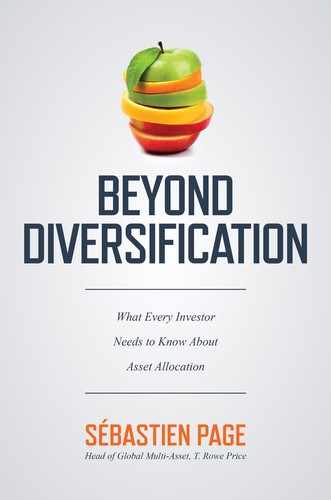PART ONE
RETURN FORECASTING
Many skeptics will argue that the hypotheses behind the model can’t be verified, and therefore, we can’t use it in practice. But our goal is not to describe all the complexities of real life. Rather, we want to provide tools to help decision-making. If the model improves the odds that we’ll make the right decisions, then we should use it.
—JPP
A note to readers: I’ve included quotes by “JPP” throughout this book. I will reveal this author’s identity in the Conclusion.
Several years ago, I was half asleep at a small quantitative research conference when an interesting discussion took place. A fundamental portfolio manager (i.e., a heretic among quants1) asked the presenter, somewhat rudely, whether all portfolio optimization models were in fact completely worthless, in light of the “GIGO” critique. This question brought an immediate silence to the room. Perhaps the easiest way to annoy a quant is to bring up the GIGO critique. GIGO stands for “garbage in, garbage out.” The questioner was arguing that because we can’t estimate expected returns with any reasonable level of confidence (garbage in), the output of portfolio optimization models will always be wrong (garbage out). There is validity to this critique in that portfolio optimization models often give a false sense of precision. And ultimately, there’s no such thing as financial alchemy—a calculator can’t turn bad inputs into the right answer (portfolio optimization models are, broadly speaking, sophisticated calculators).
The presenter was Dr. Bernd Scherer, a highly regarded thought leader who has straddled the worlds of academia and investment practice for many years. Dr. Scherer was jet-lagged. He had just flown in from overseas, and he was not in the mood for a philosophical discussion on the GIGO critique. In one short sentence, he gave the most remarkable rebuttal of the critique I had ever heard. His answer ended the debate before it started, and it has stayed with me throughout the years. I must admit, I’ve used it a few times myself. He said, “If you don’t think you can estimate expected returns, you shouldn’t be in the investment business.”
Investing is mostly about forecasting returns. Even investors who don’t formulate expected returns as a precise number make implicit forecasts when they pick stocks or bonds or allocate assets. These implicit forecasts aren’t precise, but they require a view on directionality (up or down? outperform or underperform?) and, to a certain extent, magnitude, as reflected in position sizing. Even proponents of risk parity (more on this topic in Chapter 14) make implicit return assumptions when they equalize risk contributions in their portfolio. Of course, there’s more to the story. We must balance our return expectations against risk. And we must think about correlations, goals, time horizon, risk tolerance, liabilities, and so on. But to echo Dr. Scherer, it’s hard to call yourself an investor if you don’t think you have insights about expected returns.
There are many ways to estimate expected returns, from fundamental to quantitative approaches and everything in between. Over the years, I’ve worked with fundamental investors who broadly dismiss quantitative models as naïve, usually on the basis that the models rely on past data. Also, I’ve worked with quants who think fundamental approaches lack rigor and amount to a collection of made-up stories. Most successful investors are less dogmatic, and their views lie somewhere between these two extremes. They believe that a combination of powerful quantitative data analysis and fundamental, forward-looking judgment leads to the best outcomes.
The challenge, of course, is how to marry fundamental and quantitative approaches. I will make suggestions in this chapter. But first, the criticism that quantitative expected returns are flawed because they use historical (as opposed to “forward-looking”) information merits a rebuttal. As for GIGO, the critique used to make my blood pressure spike.
During the first few years of my career at State Street, a significant part of my responsibilities was to help develop quantitative expected returns. Sometimes clients would question the models. They would say, “This approach doesn’t work, because it’s not forward-looking—it’s based on past data, and the current environment is different.”
I loved my job at State Street, but the global travel schedule was grueling. So like Dr. Scherer, one day I was jet-lagged and gave a client a curt answer. I said: “I’m sorry. I’ve looked everywhere for future data, but I can’t find any. They’re not on Bloomberg.”
The salesperson who had invited me to present to this client was not impressed. The point is that historical data are all we have. They are useful to the extent they help formulate a view about the future. It’s in that context that I review various approaches to expected returns in this chapter.
Note
1. A “quant” is an industry term used to describe those involved in quantitative research and investment management. Quants use computer models and mathematics to predict markets and manage risk.
